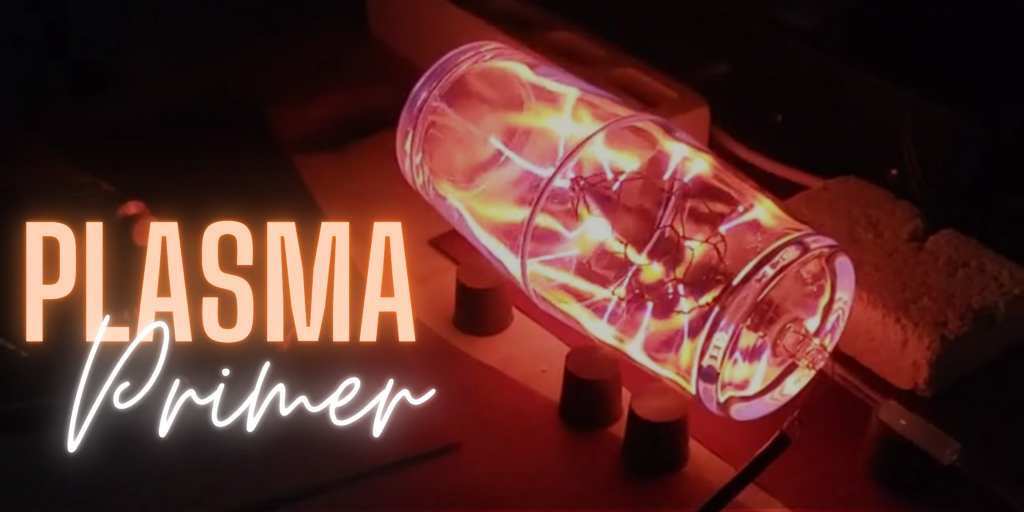Hello Lightning Tamers!
I was asked a question by Patreon supporter and co-learner Liz K.
“Have you noticed performance differences between the Eco Spark Coil and the more “traditional” spark coils? I was trying the Eco Spark Coil out today with some of the leaky panels and had a really hard time finding leaks. Only one seemed to have a leak where the electrode joined to the panel.
I figure part of it is because some of those panels were pretty hard to find leaks when we did the workshop, but I also wondered if maybe the traditional spark coils are more powerful or tend to show leaks more easily? What has your experience been like?”
I want to use this question to frame three points: What tools are available for leak detection, what leak detection looks like, and what the limitations are—and how to troubleshoot them.
Plasma is a challenging medium, as the scope of the practice requires broad knowledge of glass making, gas mixing, and the use of various tools and technologies. ( Elements of Plasma | Visual Diagram 2nd edition )
As such, one of the major challenges that we face is leaks from improper seals (Chapter TWO x Notes – Plasma Guidelines for Vessel Structure, 2nd Edition, slide 14). These often take the form of tiny holes or gaps between glass pieces, whether or not electrodes are involved. Sometimes, foreign particles or dust between sealing surfaces cause leaks.
Creating a truly vacuum-sealable vessel—distinct from being merely airtight—is the first threshold in plasma sculpture. Without this, we can’t properly fill the vessel with gases.
Let me underscore this:
No matter how skilled or informed you are, vacuum leaks remain the most common failure point in plasma. Even experienced plasma artists regularly confront this issue. A piece may appear visually flawless, but still fail to hold a vacuum.
Plasma asks you to become better. As long as you do your best, every failure becomes a lesson.
One warning: if the spark coil is held too long on one spot, it can puncture the glass (Handbook of Electron Tube and Vacuum Techniques, Rosebury, p. 134) or create local heating that cracks the surface (Modern Vacuum Practice, Harris, p. 382).
The spark coil can highlight flaws in construction—thin walls, surface tunneling (when creating points or peaks), or poorly fused connections.
So let’s get to the question at hand. I’ll do my best to answer with both experience and citation.
Q: Are there significant differences between the Eco Spark Coil and the BD-10AS High Frequency Generator used in neon and scientific glass?
The Eco Spark Coil has a slightly lower output than the BD-10AS. The BD-10AS produces between 20–45 kV at 1 mA (HSBD-10AS Instructions.pdf), while the Eco Spark Coil falls between 20–35 kV.
Functionally, they perform similarly. The main difference shows up in price.
Shameless plug: Through the Taming Lightning Store, I offer a more affordable version of the same tool—based on the Oudin coil—repurposed from a high-frequency beauty wand with a 3D-printed blunted tip, for just $36.98.


The BD-10AS, while industry-standard and made in the U.S., is $319 through Electro-Technic Products and up to $395 via EGL. Anecdotally, I’ve picked up seven of these from neon shop donations, and only one or two still worked. It’s effective—but not always durable.
Q: I’m having a hard time finding leaks—only at the electrode. When is the spark coil effective, and are there other tricks to help?
Most leaks in plasma vessels can be located using a spark coil (or Tesla coil) (Scientific Glassblowing, Wheeler, p. 368). It’s most effective in a specific pressure range: between 0.001 mbar (0.75 mTorr) and 100 mbar (75 Torr). At this range, as the coil’s discharge passes over glass surfaces, the spark will concentrate and glow at the location of micro-cracks or pinholes (Modern Vacuum Practice, Harris, p. 382).
When the Spark Coil Isn’t Enough: Detecting Large and Tiny Leaks
While the spark coil is essential, it doesn’t catch everything. Some leaks are simply too big or too small to be detected this way.
Detecting Large Leaks
If you’re dealing with a large leak and the spark coil doesn’t reveal it:
- Listen: Whistling or gurgling from your pump often means a large, visible hole.
- Typical locations: Tubulation, electrode seals, or part attachments.
- Manual techniques:
- Feel for airflow: Use your hand to sense movement and block the leak momentarily.
- Flame disturbance: Isolate your vacuum system, gently blow air over the vessel, and use a hand torch with a soft propane flame to observe flickering.
- useful around tabulation seals and with glass with thermal resistance, such borosilicate
- *Can be used on furnace-blown glass during the glassmaking process.
Detecting Small Leaks
When a leak is too small to trigger the spark coil and isn’t audible, but your vacuum gauge isn’t reaching maximum:
- Try the Pressure Change Method: Lightly spray isopropyl alcohol or low-purity nitrogen on the vessel under vacuum and watch your gauge:
- A brief pressure rise means vapor entered through a leak.
- A temporary drop could mean the vapor briefly sealed it (Rosebury, p. 135).
The Last Resort: Helium Leak Detection
If all else fails, the most sensitive tool is a helium leak detector. It’s the standard in scientific and industrial settings and can detect leaks too small for other methods. While often cost-prohibitive for small studios, it may be worth the investment if your practice depends on achieving consistent vacuum quality (Harris, p. 382).
Have your own methods or experiences with leak detection? Drop a comment below or reach out—I’d love to hear your approach.
Stay bright,
Percy Echols II, Taming Lightning

Bibliography
- Harris, Nigel S. Modern Vacuum Practice. 3rd ed. Great Britain? Nigel S. Harris, 2007. https://external.dandelon.com/download/attachments/dandelon/ids/DE004F6977097F72158CFC125749D00345AD8.pdf
- Rosebury, Fred. Handbook of Electron Tube and Vacuum Techniques. New York: American Inst. Of Physics, 1993. https://archive.org/details/handbookofelectr0000fred/page/134/mode/2up?view=theater.
- Roth, A. Vacuum Sealing Techniques. New York: American Institute Of Physics, 1994. https://archive.org/details/vacuumsealingtec0000roth/page/14/mode/2up?view=theater.
- Varian. Basic Vacuum Practice. 3rd ed. Lexington, MA: Varian Associates Incorporated, 1992. https://solaratm.com/uploads/2017/08/Basic-Vacuum-Practice.pdf.
- Wheeler, E.L. Scientific Glassblowing. 1958. Reprint, Sandy, UT, USA: Ingenius Glassworks, LLC, 1958. https://archive.org/details/cftri.4145scientificglassb0000elwh





